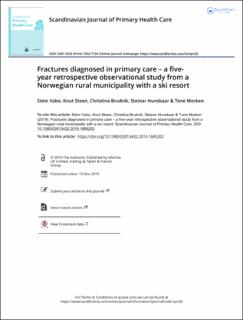| dc.description.abstract | Objective: The aim of this study was to characterize fractures recorded at a Norwegian primary care centre near a ski resort.
Design: A retrospective five-year observational study in the period 2010–2014.
Setting: A primary care centre equipped with an x-ray machine and located near a ski resort in a small rural municipality of 931 inhabitants in Norway. The X-ray images are digitalized and instantly transferred for assessment of a radiologist and/or an orthopedic surgeon both before and after treatment.
Subjects: All patients with radiologically confirmed fractures.
Results: A total of 1154 X-ray examinations were done, out of which 480 (41.6%) were fractures verified by a radiologist. The most frequent fractures were in the wrist (30%), collarbone (15%), shin (11%), humerus (9%) and ankle (8%). 316 (66%) of the fractures were in males and of these 225 were in age group 10–19 years. Males dominated among fractures in collarbone (92% males), finger (80% males), and foot (85% males). Women with fractures of the wrist, ankle, humerus and metacarpal bones, had a higher median age than men with similar fractures. Nonsurgical treatment with cast or braces was initially offered in 371 (77%) of the fracture-cases at the primary care level.
Conclusion: Young men acquired most of the fractures, predominantly in the wrist, and mostly during the winter sport season. Nearly eight of ten fractures were treated locally in primary care centre.
Key points
A large seasonal variation was found in number of patients with fractures.
More than 60% had fractures in the wrist, collarbone, shin or ankle.
More than half of the patients with a fracture were males and below 20 years old.
Most fractures were ski-related. | |

